Shift Your Negative Mood – Forever
Top Trending Posts

As leaders, moods shape our worlds. We wake to a mood every day. We interact with the moods of those people we live with and work with. In fact, every interaction, involves engaging with a mood of some description – your mood and that of the other. In reading this now, you might detect a mood in yourself?
If you’re a leader who identifies with being in an unhelpful or unconstructive mood often, this is for you.
We suggest there are few excuses for entering a workspace with an unhelpful mood and making others suffer the consequence. Instead, we advocate that you take the time to understand moods, how they’re constructed and learn how to shift them – for the sake of you, your team and those you interact (and live) with.
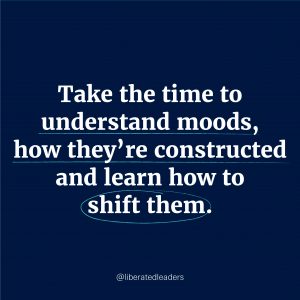
There are many ways to shift a mood and there are different kinds of moods. The transitional moods we feel through the day, like frustration, disappointment or overwhelm, can be shifted when we recognise they’re with us, and belong to us. Simple interventions can work to shift these moods. We suggest moving your body, listening to music, changing tasks, removing yourself from a situation or asking yourself a short ‘check in question’ to help you see where you are stuck.
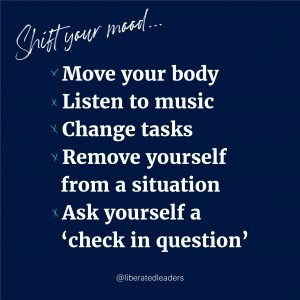
The more pervasive moods – deeper more ‘existential’ moods like resentment, anxiety and resignation – require a more deliberate ‘unpacking’. This unpacking typically involves:
- Recognising the moods you find yourself in, and declaring a desire to shift out of those you find unhelpful.
- Exploring the origins of these deeper moods and the narratives or stories that accompany these moods.
- Learning to observe the key moments when moods arise and cultivating new practices in these exact moments to prevent you enacting your old habits and behaviours.
- Continuing to practice observing your new, chosen behaviours, so that over time, your old habits give way for more constructive ones, creating space for you to reinvent yourself in the context of your changing world.
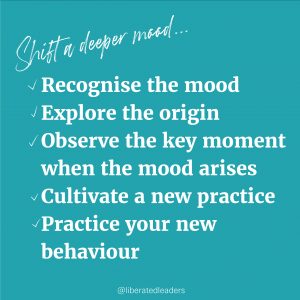
So, What Is A Mood?
Moods arise in response to recurrent narratives you have about yourself, what you care about and the contexts within which you live and lead. Because they’re recurrent ways of thinking, feeling and being in the world, you might find them hard to detect, or it might not be until you do or say something (somewhat unhelpful) that you realise you’re in a mood and how it may be affecting you (and others).
Think of your first thoughts when you wake in the morning and you’ll notice that the quality of your ‘story’ probably sets the tone for your day.
If your first thought is dread, then it’s pretty hard to shake that off and walk into work feeling buoyant! If your first thought is ‘woo hoo another magical day’, then showing up to work full of optimism may be far easier. In both circumstances, moods are present.

The quality of your thoughts and narratives is a great place to begin exploring. In all likelihood, the narrative (what you tell yourself about what’s happening) or the story that you find yourself in regularly is not a new one. If we dig around into your history, your early influences, and explore your tendency to ‘think a certain way’, we typically uncover the origin of what we call your existential moods.
Existential moods are ones we are born into. Your family and culture have a lot to do with the prevailing moods you generate for yourself and others. Your history shapes your existential moods.
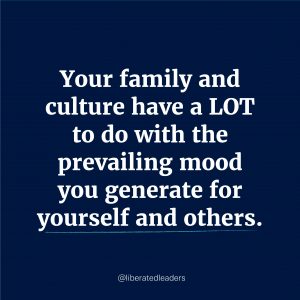
Consider these longstanding moods like sets of shaded glasses that colour your world a particular way. And because you have been wearing them for a long time (your whole life normally), you can be fooled into thinking the world really is the way you see it through your filter. You might even think others see things this same way.
Some examples of existential narratives sound like this:
- “The world is not safe, therefore I need to be on guard and cautious”. This narrative can provoke the mood of anxiety and has us operating from a space of defensiveness.
- “I’ve never really felt good enough, therefore I’d better make sure everything’s perfect”. This narrative has us generate high standards for self and others and may provoke a sense of resentment when others cannot (or cannot be bothered) meeting the standard.
- “I’m not really worthy of others care and attention, therefore, I’ll take what I get”. This narrative likely has us play it pretty safe and may generate the mood of resignation, and a feeling that this is ‘our lot’ in life.
Note that these kinds of moods seem ‘old’ and feel more like a worldview than ‘just a mood’.
The thing is that world views translate to moods and in order to ‘break up’ with an old and unhelpful mood, recognising it and its origins is the first step.
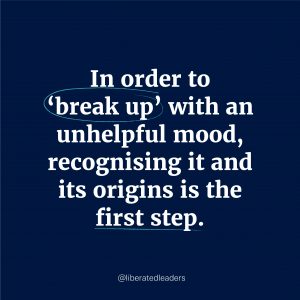
Here’s a great example.
We’ve been working with Brenda, the CEO of a major corporation. She’s highly successful in terms of position with accolades as a leader in her industry. Brenda is one of those people that seems to achieve an enormous volume of work in a week – and tend to her extra curricula activities too! She is impeccable with time and commitments and sets a standard that others find hard to meet. This is great for those who work with Brenda, but in the months since COVID, Brenda felt her formula (and normal energy level) fade. She’d started to feel the strain of the standards she’d established for herself – and was struggling to maintain her identity – everyone expected her to be like this all the time – and she had nothing left.
Through COVID, and forced to rethink how she did her work, things began to change for her. She felt less inclined to push herself as she once did. She began to relish working from home and although her hours were long, her ‘quality of life’ took on a different level of importance for her. She slowed down just enough to ask herself some important questions.
- For the sake of what do I work 14-hour days?
- Why is it I feel so responsible for others?
- How is it that I seem to care more for others wellbeing than my own?
- How is it that I am taking care of my wellbeing?
- What kind of relationship do I want with my family?
- What’s that feeling I get when I am not busy?
- If I stop working like this, what might my life be?
- What are the consequences for me and my family if I don’t change?
These kinds of questions are profound. They had Brenda experience a glimmer of another way of working, leading and living.
For most people, Brenda’s ‘pause’ to reflect might seem like a crisis, but in exploring how it is that she constructed her identity and the narrative at the heart of that, Brenda came to realise that her high performing standards were developed to take care of an old and deep concern – that of ‘not being enough’.
She learned early in her career that when she ‘moved to action’, mobilised others, over-delivered relative to others and was always at the forefront of initiatives, the recognition and reward she achieved, filled her empty “I’m not enough” bucket. It was a tactic she employed early in life to feel enough every day and soon the rewards overshadowed that empty feeling. In her work domain this played out wonderfully. She was promoted and recognised for her achievements and is still today identified as one of the most talented in her field.
In revealing her habitual patterns of thinking and behaving, Brenda discovered the narratives that may have translated to success in the past, had grown tired and were now limiting what was possible in her future. They did not feel like hers anymore – more an unwanted inheritance.
The answers she arrived at did not translate to a dramatic shift away from herself or her leaving her job – a consequence you might fear when journeying like this. Her liberation was being able to see the habits of thinking and behaving that caused her to feel trapped by her success rather than freed by it.
So where is she now and how is she doing? Working an honest 50-hour week (with the odd 14 hour day), allowing others to stretch and take on what Brenda used to ‘pick up’ (she lets them do this without a desire to rescue), her team experiencing her as less ‘edgy’ to interact with, using some of her spare time for quality time with the children and exploring her interests outside of work (a once foreign idea).
Emerging from COVID perhaps you too are grappling with your sense of identity and who you want to be in the next part of your journey?
Perhaps you’re feeling a sense of loss and discontent, or a desire to escape or get out of the ‘rat race’. We invite you to consider moods as a starting place. Moods are the ultimate clue that there’s something to explore, reflect on and discover in the self-renewal journey. If you want to step out of the heavy moods that have you feel trepidation and uncertainty, and cultivate more constructive moods as a catalyst to your grand adventure (life), stay in our conversation, or reach out to understand how we can support you to REALLY explore the practice of feeling Liberated – in Leadership and LIFE.
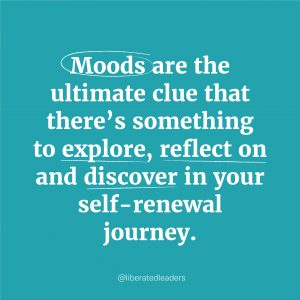
Our 8-Month Foundations Program identifies and reveals the MOODS you lead from and how to shift these for the sake of creating a culture that enables creative thinking, collaboration and above all possibility. CLICK HERE TO LEARN MORE
Share This
Top Trending Posts
Sign Up
to our blogs and receive regular updates.

Stay in the Conversation
with Liberated Leaders...






